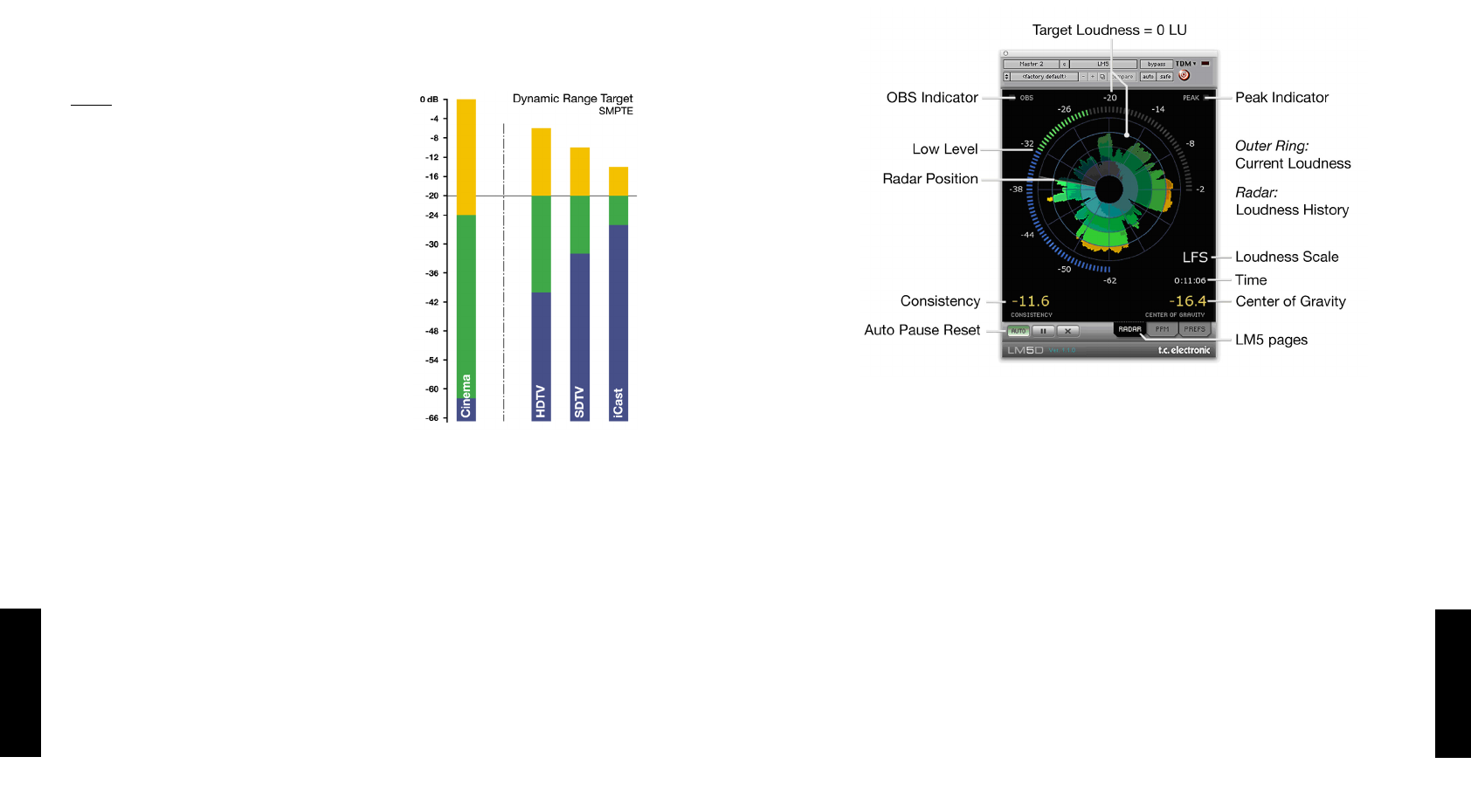
LM5 & LM5D -TDM
/
5
EE NN GG LL II SS HH
EE NN GG LL II SS HH
4/
LM5 & LM5D -TDM
When production engineers realize the boundaries they should generally stay within,
less dynamics processing is automatically needed during distribution, and the
requirement for maintaining time-consuming metadata at a broadcast station is
minimized. In broadcast, the goal is to use the same loudness measure for
- Production,
- Ingest,
- Linking
- Master Control Processing
- Logging
thereby ensuring better audio quality not only in DTV audio, but across all broadcast
platforms. LM5 and TC processing can co-exist with PPM meters, VU meters or
Dolby’s LM100 meter. LM5 greatly increases the usability of LM100 in production
environments because it provides running status, and gives a standardized indication
of both dialog and non-dialog program.
Fig 2, Color coding and target
loudness for selected broadcast
platforms based on a consumer’s
Dynamic Range Tolerance, DRT.
The aim is to center dynamic range
restriction around average loudness, in
this case the –20 dB line, thereby
automatically avoiding to wash out
differences between foreground and
background elements of a mix.
Note how different the broadcast
requirements are from those of
Cinema.
ever decreasing dynamic range. By now, the pop music industry is “right of” In Flight
Entertainment in the illustration.
LM5 offers a standardized option: The visualization of loudness history and DRT in
combination with long-term descriptors from production onwards, is a transparent and
well sounding alternative to our current peak level obsession. Not only for music, but
also in production for broadcast or film. The engineer, who may not be an audio
expert, should be able to identify and consciously work with loudness developments
within the limits of a target distribution platform, and with predictable results when
the program is transcoded to another platform.
LM5 therefore color codes loudness so it’s easy to identify target level (green), below
the noisefloor level (blue), or loud events (yellow), see Fig 2.
BASIC USE
LM5 makes use of a unique way of visualizing short-term loudness, loudness history,
and long-term statistical descriptors (LM5D only). It may be used with mono, stereo
and 5.1 material for any type of program material.
Press the “Radar” key to bring up the Radar page. This page will probably be used
most of the time. The basic functionality of the Radar page is shown in Fig 3.
Fig 3, Radar page features of LM5D.
Target Loudness is displayed at 12 o’clock of the outer ring, and at the bold,
concentric circle of the radar. The Universal Descriptors, Consistency and Center of
Gravity (LM5D only), are the yellow numbers in the lower part of the display. Press the
“X” key to reset Radar and Descriptors.
The “Transport Controls”, Auto, Pause and Reset, are used to make the radar and
descriptor measurements run, pause and reset. When “Auto” is pressed, run (green)
and pause (yellow) follows the ProTools transports.
Press the “PPM” key to bring up the PPM page as shown in Fig 6. The PPM display is
used to inspect balance between channels, overload of channels etc.
Press the “Prefs” key to bring up the Preferences display as shown in Fig 8. Note that
you can “zoom” in time or radar resolution, as long as the history is not reset. For
instance, change between 4 min per revolution to 1 hour per revolution, or 6 dB per
division to 10 dB per division.
Presets can be stored specifying target loudness, noise floor, overload conditions etc.














